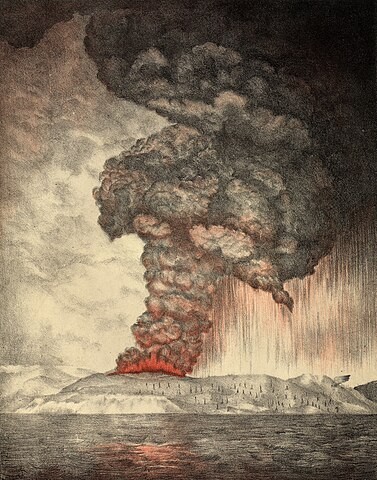Krakatoa, a volcanic island located in the Sunda Strait in Indonesia, is known for its cataclysmic history, particularly the enormous eruption in 1883. This event ranks as one of the most powerful volcanic eruptions in recorded history. Here’s an exploration of Krakatoa’s cataclysmic history and its significance:
Key Historical Events:
- Pre-1883 Eruptions: Prior to the catastrophic eruption in 1883, Krakatoa had been an active volcano, with several eruptions documented in the 17th and 18th centuries. These earlier eruptions hinted at the potential for a major event.

- 1883 Eruption: The eruption of Krakatoa in 1883 is infamous. On August 26, 1883, the volcano experienced a series of colossal explosions. The eruption sent a massive column of ash, gas, and rock over 24 miles (40 kilometers) into the atmosphere. The explosion generated shockwaves that were felt around the world. The most powerful explosion was heard over 3,000 miles away.
- Tsunamis: The eruption triggered tsunamis that affected nearby coastal regions. The tsunamis reached as far as South America, causing widespread destruction and loss of life.
- Climate Effects: The massive amount of volcanic ash and aerosols ejected into the atmosphere led to a temporary cooling of the Earth’s climate. The following year, 1884, became known as the “Year Without a Summer,” affecting weather patterns and agriculture worldwide.
Effects of the 1883 Eruption:
- Island Destruction: The eruption led to the obliteration of the volcanic island of Krakatoa, leaving a caldera where the island once stood.
- Deaths and Destruction: The eruption and its associated tsunamis caused significant loss of life, with estimates of fatalities ranging from tens of thousands to over 36,000. It also devastated coastal towns and villages.
- Scientific Insights: The Krakatoa eruption provided valuable scientific data and insights into the behavior of volcanic eruptions, the dynamics of volcanic explosions, and the global impact of volcanic ash in the atmosphere.
Modern Krakatoa:
- Anak Krakatau: Over time, volcanic activity resumed in the vicinity of the old Krakatoa, leading to the emergence of a new island called Anak Krakatau, which means “Child of Krakatoa.” This new island has been growing through continued volcanic eruptions.
- Ongoing Monitoring: Anak Krakatau is closely monitored by authorities and scientists. While it is currently much smaller in scale than the original Krakatoa, it remains an active and potentially hazardous volcano.
- Tourism: Visitors are drawn to the area for its geological significance and the opportunity to witness an active volcano. Tours and hikes to Anak Krakatau are offered, but safety measures are essential.
Krakatoa’s 1883 eruption is a testament to the incredible power and destructive force of volcanic activity. The legacy of this event has left its mark on geology, climate science, and the history of natural disasters. Today, Krakatoa serves as a reminder of the importance of monitoring and understanding the Earth’s dynamic and sometimes volatile geological processes.











